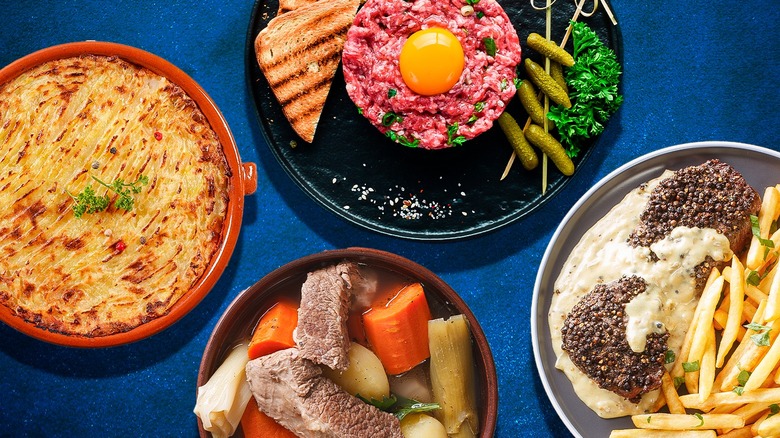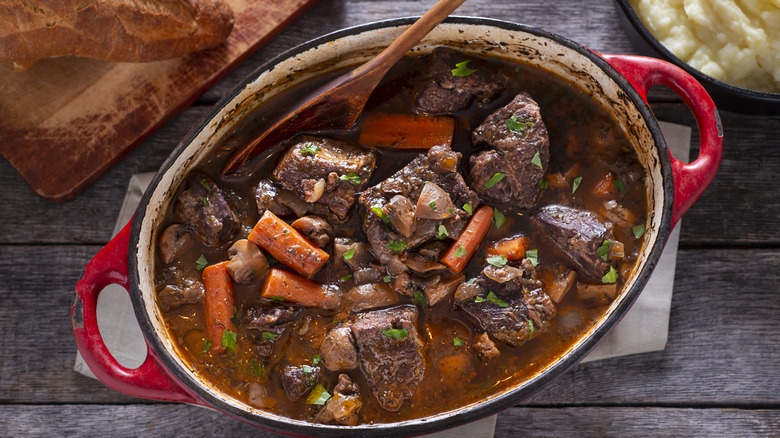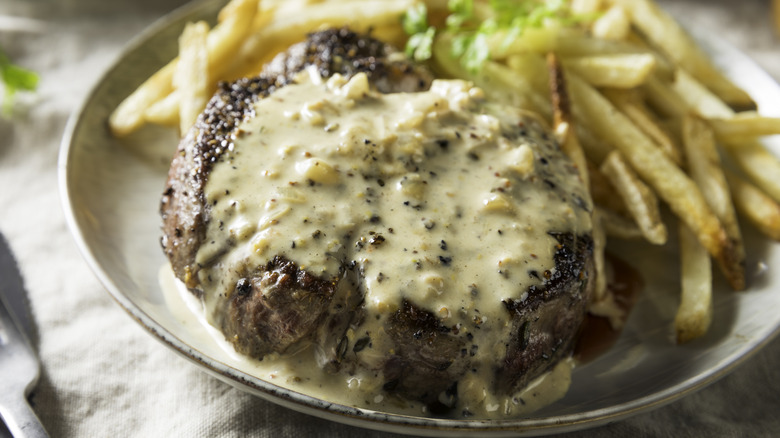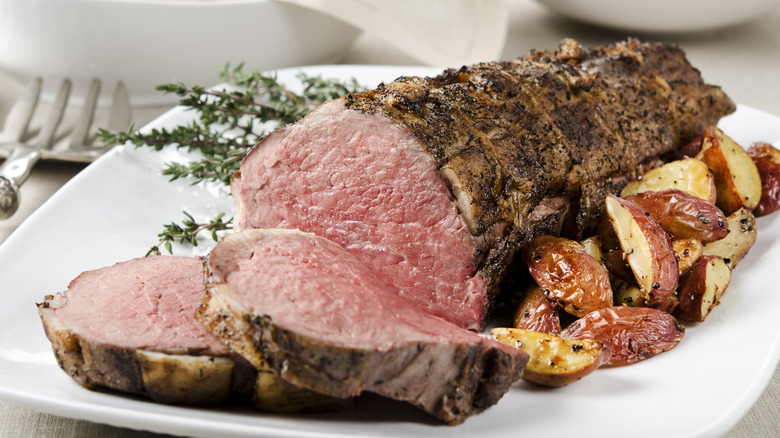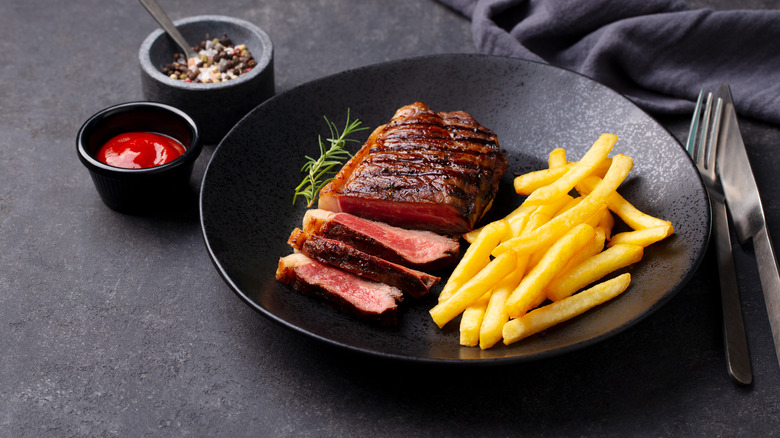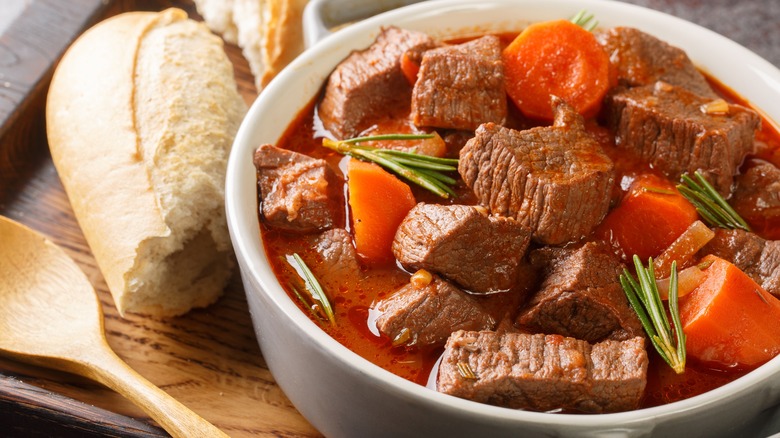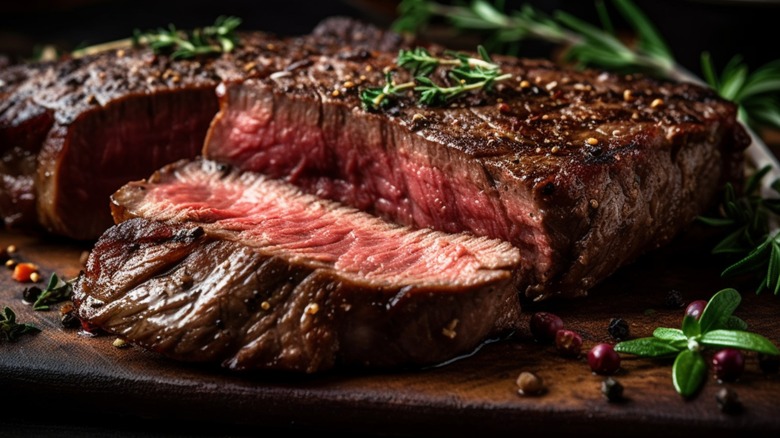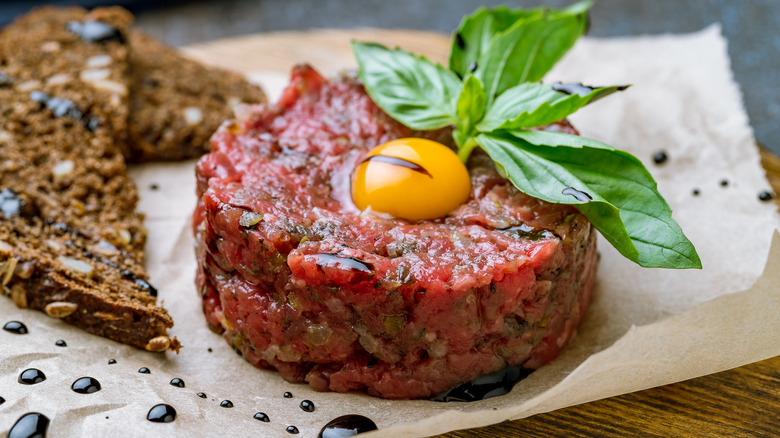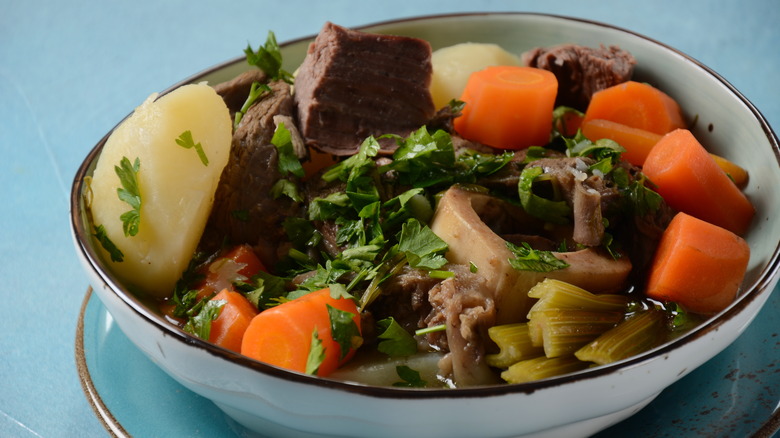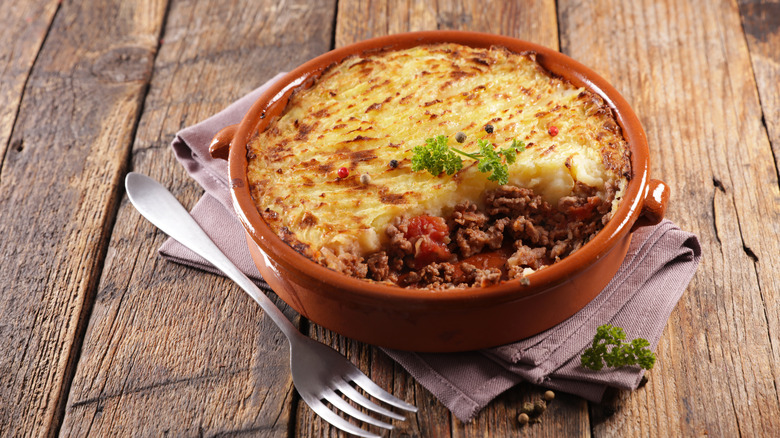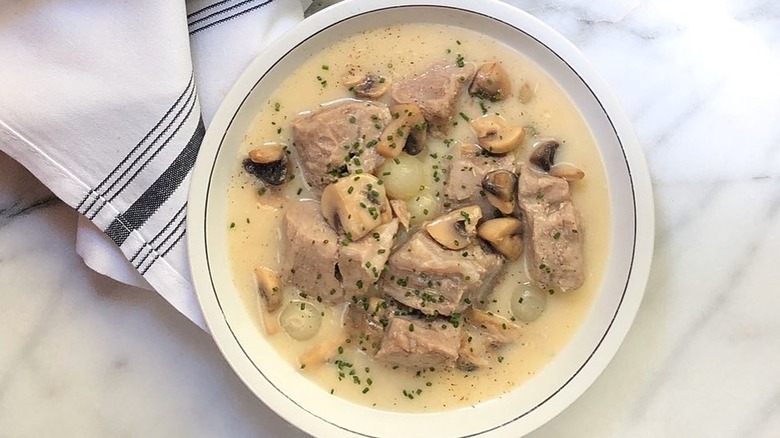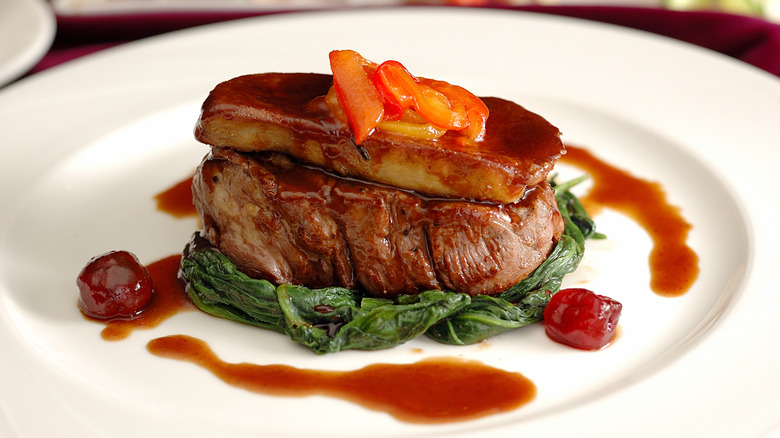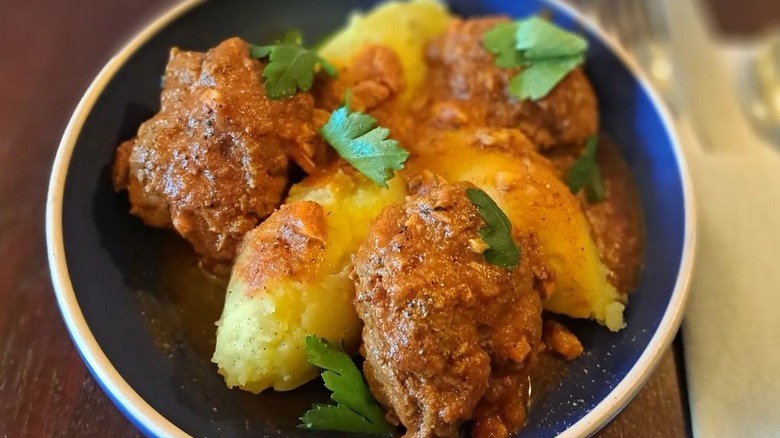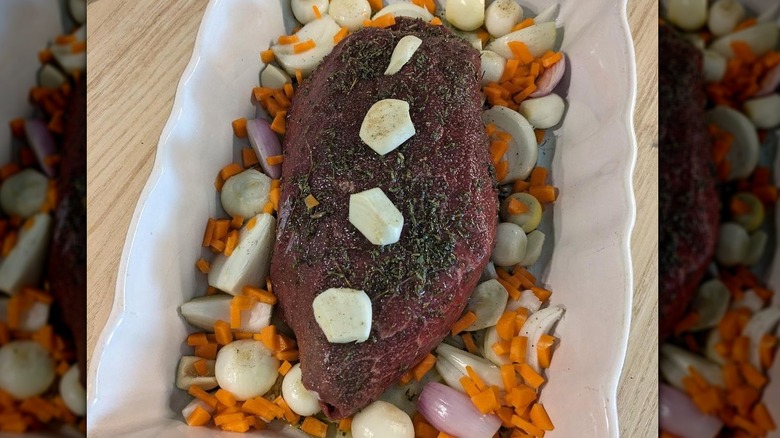13 French Beef Dishes You Should Know About
When you think of French food, cheese, bread, snails, or crêpes likely come to mind. While these represent some of France's most popular food exports, they only scratch the surface of what France has to offer. Indeed, France also boasts a thriving beef industry. With such an abundant supply, it is no wonder the French are among the world's foremost beef consumers.
But what exactly do the French do with all this beef? Or, more precisely, how do they prepare it? The answer lies in this article. Here, you will discover a ton of iconic French beef dishes. These selections range from hearty stews like boeuf bourguignon and daube de boeuf to upscale offerings like Chateaubriand and tournedos Rossini. Regardless of the cut of meat or the preparation style, each dish tells a unique story about French gastronomy, inviting diners to savor a slice of the country's rich culinary heritage.
Boeuf bourguignon
Boeuf bourguignon, arguably one of France's most beloved beef dishes, is France's answer to beef stew. Its name, which translates to Burgundy beef, pays homage to the Burgundy region of France, an area known for its quality beef and red wine. Unsurprisingly, beef is at the heart of this dish, but not just any cut will do. Fatty, collagen-rich cuts like beef chuck or short rib are ideal, as they stay juicy and tender throughout the lengthy cooking process. As important as the beef is, it's the lardons (aka smoked pork belly cut into matchsticks) that kickstart the cooking process. Next, the beef browns in the rendered bacon fat. This process sets off the Maillard reaction, creating deep, roasted flavor notes.
After the meat finishes cooking, a medley of vegetables — carrots, pearl onions, and garlic — join the pan, followed by tomato paste and beef broth. Then comes the second star ingredient: red wine. While purists will insist on using Burgundy wines, any decent bottle of pinot noir, merlot, or cabernet sauvignon will do in a pinch. After spending an hour and a half in the oven, sautéed cremini or button mushrooms are added for the final 30 minutes of cooking, enriching the stew with their earthy, umami richness. The whole process takes upwards of three hours, but this hearty, indulgent stew is worth every minute.
Steak au poivre
France's Normandy region is known for many things, including the D-Day beaches, Mont-Saint-Michel, and cider. Add to that list steak au poivre (steak with pepper), a seemingly simple yet incredibly flavorful French beef dish. Traditionally, steak au poivre is made using filet mignon, an expensive cut taken from the smaller end of the tenderloin. This relatively flavorless cut of meat is ideal because it lacks the connective tissue and marbling that gives other cuts their flavor. While this might initially be seen as a downside, it allows the flavors of the seared peppercorns and cream sauce to shine.
Dating back to 19th-century Normandy bistros, the preparation of steak au poivre is refreshingly uncomplicated. The raw filet is coated in cracked peppercorns and then seared in butter. A luxurious sauce of cognac, beef stock, and cream is drizzled over the cooked steak, balancing its peppery kick with creamy richness. While this dish may have faded from the spotlight on restaurant menus, you can easily recreate its magic at home with chef Steve Corry's steak au poivre recipe.
Chateaubriand
Chateaubriand is both a dish and a preparation method that originated in 19th-century France. This steak dish takes its name from François-René, Vicomte de Chateaubriand, a French writer, politician, and aristocrat whose chef invented the dish in 1822. It didn't take long for the eponymous dish to take off.
What makes Chateaubriand special isn't the super fancy French moniker, but rather the exceptional quality of the cut. It comes from the tenderloin, an oblong muscle that runs parallel to the cow's spine and connects to the rump. Like the neighboring filet mignon, Chateaubriand is low in fat and contains minimal tendons, resulting in a soft, melt-in-your-mouth texture. Whereas filet mignon comes from the end section of the tenderloin, Chateaubriand is a large center cut. It weighs about 2 pounds, making it more than enough for two to three people.
Traditionally, preparing Chateaubriand involves stuffing the tenderloin with a spiced blend of beef marrow, then enrobing it in inexpensive cuts of beef to seal in moisture. Nowadays, a simpler approach prevails — pan-searing followed by oven roasting. This method yields a delectable contrast of a nutty, caramelized exterior and a juicy, slightly sweet interior. Accompanied by Béarnaise sauce, a red wine reduction, or peppercorn sauce, Chateaubriand is typically served sliced on a wooden board, complemented by simple sides such as roasted potatoes or grilled vegetables that allow the meat's flavors to take center stage.
Steak frites
When one thinks of French cuisine, images of elegant white tablecloths, tuxedoed waiters, and elaborate, time-intensive recipes often come to mind. While this is certainly the case on certain occasions, the reality for most French diners is quite different. More often than not, they gravitate towards simpler brasserie classics for everyday meals. One such favorite is steak frites, a dish as straightforward as its name suggests: steak and fries.
But don't let the apparent simplicity of this dish fool you. For just as French women can pull off that insouciant, I-just-woke-up-like-this look and still ooze sophistication, so too does this humble meal possess the power to dazzle. The appeal lies in the interplay of flavors and textures, where the crispy, golden fries perfectly complement the tenderness of the steak. Rump steak, ribeye, or flank steak are the most commonly used cuts and are usually cooked rare to medium rare. As for the fries, starchy russets or Yukon golds are two popular options. And don't forget the dipping sauce. Here, you can expect anything from a simple pan sauce to a more elaborate condiment such as hollandaise or béarnaise.
Daube de boeuf
Visitors often conjure up images of lavender fields, hilltop villages, and vibrant markets when picturing Provence. Yet, for the French, the charm of the region lies in its more nuanced pleasures — leisurely savoring a chilled glass of pastis, engaging in a friendly game of pétanque, and indulging in daube de bœuf, a slow-cooked beef stew emblematic of the region.
Daube de bœuf stands out from other beef stews due to its unique preparation. In this recipe, affordable cuts of meat like shanks, chuck, and cheeks are marinated overnight in red wine, preferably a local variety such as Côtes du Rhône or Côtes du Ventoux. Complementing the meat are onions, garlic, thyme, bay leaves, cloves, and an unexpected twist: fresh orange juice and zest. Additional ingredients like carrots, bacon, tomatoes, black olives, and anchovy filets may also find their way into certain versions. Some variations even opt for white wine or substitute beef with lamb or rabbit.
After marinating overnight, the beef is slow-cooked in a daubière, a covered clay pot that lends its name to the dish. The daubière's bulbous shape gently cooks the meat and facilitates a convection process, where heat rises from the bottom, hits the cooler top and cascades back down over the meat. This process transforms the collagen in the meat into gelatin, resulting in a smooth texture.
Côte de bœuf
Côte de boeuf, translated as "side of beef," is a single rib of beef. This cut, also known as a bone-in ribeye steak, is highly marbled with fat, something that makes it as juicy as it is tender. Although not a common cut outside of France, it's essentially the same cut as an American ribeye steak, just with the bone included. Generally, côte de bœuf measures 2 to 3 inches thick and weighs upwards of 2 pounds, making it large enough to feed three to four people.
Cooking a côte de boeuf is an art form. Most preparations begin with a pan-sear to lock in juices, followed by a quick 15-minute roast in the oven. This process results in a rare steak, which is how most French folks prefer it. Speaking of preferences, some recipes suggest seasoning with herbs or garlic, but the classic technique is au natural, allowing the flavors of the meat to shine through. This pricey cut is usually served with a simple salad or roasted vegetables, ensuring that the meat remains the undisputed star of the meal.
Steak tartare
Along with steak frites, steak tartare is another simple beef-based brasserie meal you'll see all over France. This straightforward yet delicious dish starts with finely minced, top-quality beef (often sirloin or tenderloin) trimmed of fat and sinew. Depending on the recipe, the meat is blended with some combination of diced capers, cornichons, shallots, or parsley. Additional condiments like Worcestershire sauce, Tabasco, cognac, and ketchup might also find their way into the mix. The mixture is then shaped into hamburger-sized patties and topped with a raw egg yolk. Usually, it comes with a side of toast or fried potatoes.
Steak tartare's origin story is as intriguing as its flavors, with more than one version circulating. One particularly whimsical, albeit improbable, version claims that the dish was originally made using horse meat. Allegedly, 13th-century Tatars (formerly spelled Tartars), aka nomadic tribes from Northeastern Mongolia, would place slabs of horse meat beneath their saddles, and then enjoy the pulverized protein at the end of the day. However, a more plausible account suggests that steak tartare emerged in early 20th-century French restaurants in Polynesia. Raw meat consumption was customary in the region, and when paired with Auguste Escoffier's recently perfected tartar sauce recipe, the winning combination was born.
Pot-au-feu
Translated literally as "pot on the fire," pot-au-feu has been enjoyed in France since the Middle Ages. Back then, families would keep a pot simmering over the fire, continually adding or removing ingredients over several days. While modern cooks may not keep a cauldron bubbling around the clock, the spirit of pot-au-feu lives on in contemporary renditions. This hearty pot-au-feu stew brings together marrow bones, various cuts of beef such as ribs, rump, and shoulder, and an array of root vegetables including potatoes, carrots, onions, leeks, celery, and turnips, all seasoned with bouquet garni. Simmered together for a minimum of four hours, the result is well worth the time investment, yielding not just one, but two courses.
The first-course features marrow toast appetizers, where marrow is scooped from the bones and spread onto toasted baguettes, served alongside the strained broth. The second course consists of the meat and vegetables, strained and plated with additional broth ladled over the top. Accompaniments like horseradish sauce, mustard, and cornichons add the perfect finishing touch to this satisfying meal.
Hachis parmentier
Everything sounds better in French — it's a dictum non-Francophones have repeated for centuries. Hachis parmentier, essentially a French cottage pie, serves as another testament to this truth. The dish takes its name from the French verb "hacher," meaning "to chop," while parmentier pays homage to Antoine-Augustin Parmentier, an 18th-century French nutritionist who advocated for the potato as a dietary staple.
Similar to its British counterpart, hachis parmentier features a savory combination of beef and mashed potatoes baked into a casserole. Originally conceived as a way to repurpose leftover beef Bourguignon or Flemish beef carbonnade, nowadays, it usually features ground beef as the primary ingredient. As with any great comfort food dish, you can make this one as simple or as complex as you want. For those who prefer a minimalist approach, the meat can be cooked with just aromatics, nutmeg, and a touch of beef stock, while the potatoes require only butter and milk. To add a touch of sophistication, consider incorporating tomato paste, carrots, and a splash of white wine into the meat mixture, and don't hesitate to sprinkle some grated Parmesan cheese over the potatoes for an extra layer of flavor.
Blanquette de veau
Readers of a certain age may still wonder if veal is okay to eat. Back in the 1980s, aggressive campaigns portrayed veal production as synonymous with animal cruelty, especially due to the practice of tethering veal calves in tiny crates. However, times have changed, and more and more states have outlawed such practices. Moreover, veal production has shifted towards smaller, family-run farms that eschew growth hormones and preventative antibiotics.
With these improvements in mind, you can enjoy blanquette de veau, a French veal stew, with a clear conscience. The term blanquette denotes the initial cooking process. Rather than browning in fat, the veal simmers in a ceramic pot with white wine, bouquet garni, and carrots. While the veal cooks, mushrooms and pearl onions are prepared separately before joining the pot. Once cooked, the meat and veggies are strained and set aside. In a separate pan, a roux is made and then combined with cream and some of the cooking liquid to create a velvety sauce. This sauce is then poured over the veal and vegetables before being served with steamed rice and a delicate white wine.
Tournedos Rossini
Some French dishes, like croque monsieurs, quiche Lorraine, and ratatouille embody simplicity, accessibility, and comfort. Then there are sophisticated options like bouillabaisse, escargot, and confit de canard (confit duck), which are typically only found in the most upscale restaurants. Tournedos Rossini, a decadent beef dish featuring Chateaubriand tenderloin, belongs squarely to the second category. Named after Gioachino Rossini, the 19th-century Italian opera composer responsible for "The William Tell Overture," tournedos Rossini was allegedly created to one-up François-René, Vicomte de Chateaubriand's namesake dish. Rossini's friend Chef Casimir Moissons is credited with the extravagant creation.
Tournedos Rossini takes hours, if not days, to get right. Pulling together the Madeira wine sauce is the first major hurdle, as it involves reducing beef or veal stock and enriching it with butter, shallots, and Madeira wine. Once the sauce concentrates, the cooking process is relatively straightforward, although there are several ingredients to keep track of. The tenderloin is cut into a circular shape, seasoned, and seared over high heat until rare, then placed atop grilled bread. Seared foie gras follows, accompanied by shaved black truffles, and finally, the decadent wine sauce.
Alouettes sans têtes
Pies in the face aside, food and comedy may not seem like a natural pairing. However, there are plenty of dishes with hilarious names. For instance, the British feast on spotted dick, a pudding made from suet and dried fruit and served with custard. Meanwhile, the Taiwanese enjoy stinky tofu, a dish made by deep-frying fermented tofu. Not to be outdone, the French offer their own contribution to this whimsical culinary lexicon — alouettes sans têtes, translating to "larks without heads."
Legend has it that these beef rolls got their name thanks to their resemblance to tiny headless. Whether or not you see the resemblance, this French beef dish is definitely worth a taste. Originating from Provence, it features thinly sliced beef (typically chuck or flank) flattened and wrapped around bacon, garlic, and parsley. Other ingredients like breadcrumbs, chopped onion, and sometimes ground meat may also be added. After securing the bundle with twine, it's cooked in a skillet with aromatics, carrots, mushrooms, and tomatoes, simmering for about an hour. Once ready, the twine is removed, and the bundles are served alongside potatoes or steamed vegetables.
Roti de boeuf
Just as Americans and Brits enjoy a teasingly adversarial relationship, so do the French and the British have their own playful banter. While the British playfully refer to the French as frogs due to their occasional amphibian dishes, the French return the favor by calling the British roast beefs, a nod to their love for Sunday roast. The irony, however, is that the French also have an appreciation for good roast beef, or as they call it, "rôti de boeuf."
Typically extremely rare, French roast beef is often cooked for just 10 minutes per pound. Preparation is straightforward — simply insert sliced garlic into knife holes around the roast, coat the meat with olive oil, and sprinkle with thyme leaves. For a complete meal, you can add root vegetables and potatoes. As for sauces, the options range from simple pan gravy to more complex choices like Béarnaise or Roquefort sauce, allowing you to tailor the dish to your taste preferences.
